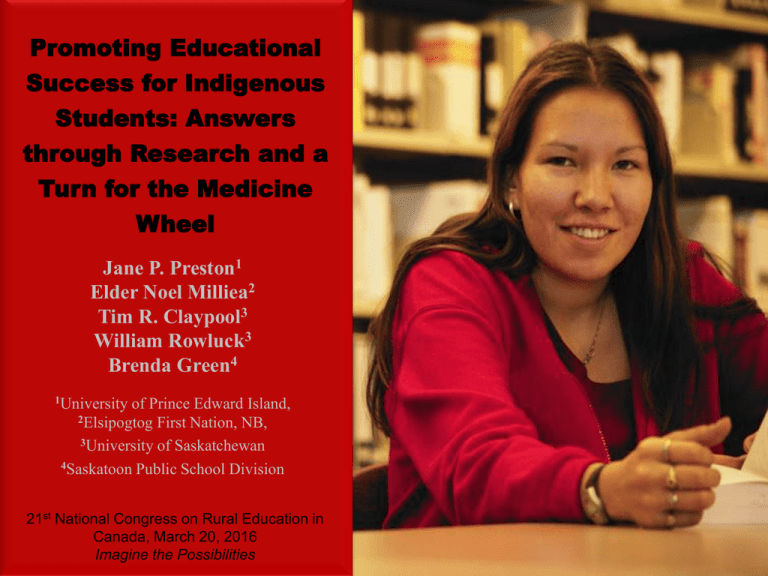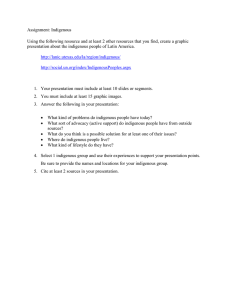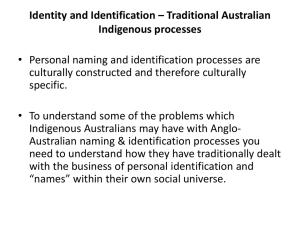Promoting Educational Success for Indigenous Students: Answers through Research and a
advertisement

Promoting Educational Success for Indigenous Students: Answers through Research and a Turn for the Medicine Wheel Jane P. Preston1 Elder Noel Milliea2 Tim R. Claypool3 William Rowluck3 Brenda Green4 1University of Prince Edward Island, 2Elsipogtog First Nation, NB, 3University of Saskatchewan 4Saskatoon Public School Division 21st National Congress on Rural Education in Canada, March 20, 2016 Imagine the Possibilities Today’s Activities 1. Honoring treaty land and ancestors 2. Introductions 3. Explaining research & results 4. Audience sharing (~25 min) 5. Break (~3:10 to 3:20) 6. Medicine Wheel teachings Noel (~3:20 to 4:30) Principal Leadership for Indigenous Student Success: A Multi-Case Study of Principals Nurturing Relationships Purpose: • To explain how principals across Saskatchewan, Prince Edward Island, and Nunavut promoted educational success for Indigenous students What is Success? Incorporates academic, physical, emotional, & spiritual wellbeing Academic success completion of courses, completion of grades, and Grade 12 graduation numbers (easiest to measure/track) Physical success strong attendance rates, healthy body, craftsmanship in industrial arts, sewing skills, or sports involvement Emotional success represented by students who feel safe, have self-confidence, and embody an eagerness to learn Spiritual wellbeing (or success) promoted in an school environment where students have the liberty to rely on intuition and inner guidance during daily activities Think-Pair-Share: Pick one of the 4 domains. Describe how a student feels when he/she experiences “success” in that domain. Literature Review • BC Min of Ed. (2014): Grade 12 grad rate for 2012-13 was 60%,compared to 40% in 2008-09. Need Aboriginal Enhancement Agreement: a. Measureable, attainable goals for students b. Indigenous curriculum c. Indigenous people employed in school d. Professional development for educators • Principal Sakewew High School interconnected governance system • Stobart Community High Principal spoke of importance of Elders presence in school • International level (Australian Principals Ass’n, 2008) a. Engage with Indigenous students, families, communities b. Focus on student attendance/completion c. Focus on appropriate curriculum/pedagogy Methodology & Design • Qualitative multi-case study (SK, PEI, NU) • Big study: 36 interviews with 23 participants. Data collection over 11 months (Jan-Nov, 2014) • Today’s results: 28 interviews with 17 principals SK PEI NU Andy* John* Stuart Brian* Karen Ted Colin* Lizzy Ulmer Dan* Melanie Victoria Ellen Winnie* Xena Yvonne* Zoe Indigenous Participant * Long-term Indigenous relationships/northern R E L A T I O N S H I P S 1. Relationships are the essence, link, chain, root of success • “The most important job we have as educators is building relationship, because relationship builds trust. And we don’t get anywhere without trust” (Colin, SK). • “What do you do to promote [Indigenous] student achievement and wellbeing in your school? I would say, relationships, relationships, relationships” (Yvonne, NU). 2. Relationships with students “Relationship is always at the heart … Because, if they [students] don’t feel comfortable with teachers or the environment, nothing’s going to happen” (Dan, SK). After-school activities such as cross-country soccer, volleyball, basketball, rugby, track-in-field, softball, drama, concert band, jazz band, book clubs, and Student Council were ideal ways to create, sustain, or maintain strong teacher-student relationships (John, PEI). Image: Trent University. (2011). Vitual tour. Retrieved from https://www.trentu.ca/takeatour/?p=s_aboriginal 3. Relationships with parents/caregivers “With parents, it’s a relationship that’s shared. We may be the educational experts but you’re the expert in your child. We need a dialogue [with parents/caregivers] to figure out what’s best for them [the students]” (Andy, SK) Stuart (NU) said it is important to always have Inuktitut translator: “Unilingual Inuit parents were able to approach us using the language they preferred.” Image: National Collaboration Center for Aboriginal Health. (n.d.). Child and Youth Health. Retrieved from http://www.nccahccnsa.ca/286/With_Dad__Strengthening_the_Circle_of_Care.nccah 4. Relationships with community/community members When Karen (PEI) was a new principal at her elementary school, she invited the Chief and a First Nation community member to her school. She asked them to help her understand what she could do to help Indigenous students. “There are people who live here for a decade and don’t have an Inuk friend. The only Inuktitut they hear is at the grocery store. They have never been on the land, gone to a community feast. … If you are going to stay in this town, you are going to have to go out in the community” (Winnie, NU). Analysis of Results: Space, Place, & Case Space • Mental and emotional head-space thoughts and comments (principals articulated relationships are important) Place • Physical infrastructure of school, time table of after-school programs, etc. Case • Physical, mental, emotional, and spiritual thoughts, feelings, and behaviors to promote Indigenous students success (thoughts, feelings, and behaviors) Fostering Relationships World Café Activity 1. Relationships with Students Within a school setting, how can relationships with between principals/teachers and Indigenous students be enhanced? 2. Relationship with Parent/Caregivers Within a school setting, how can relationships between principals/teachers and parents/caregivers be enhanced? 3. Relationship with Communities How can relationships between the school and Indigenous communities/community members be enhanced? 4. Indigenizing the Curriculum How can Indigenous knowledge and ways of knowing be better integrated into the school curriculum? 5. Self-Enhancement What can principals/educators do to enhance their relationships with Indigenous culture and ways of knowing? 6. Respectful Relationship in School Environment How can principals/teachers promote a respectful and welcoming school environment for Indigenous students, parents/caregivers, and family members? 7. Postsecondary Education What can principals/teachers do so Indigenous students are more supported/informed with regard to postsecondary education? Knowledge Dissemination from Study Journals • Preston, J. P., Claypool, T. R., Green, B., & Rowluck, W. (in press/submitted). Principal leadership for Indigenous student success: A multi-case study of principals nurturing relationship. • Preston, J. P., Claypool, T. R., Rowluck, W., Green, B. (2016). Perceptions and practices of principals: Supporting positive educational experiences for Aboriginal http://www.tandfonline.com/doi/abs/10.1080/13603124.2015.1124926#.VtQ-TJwrLIU • Preston, J. P., Claypool, T. R., Rowluck, W., & Green, B. (2015). Exploring the concepts of traditional Inuit leadership and effective school leadership in Nunavut (Canada). Comparative and International Education, 44(2), 1–16. http://ir.lib.uwo.ca/cgi/viewcontent.cgi?article=1367&context=cie-eci • Preston, J. P., Claypool R. T., Green, B., Rowluck, W., & Martin, J. A. (2015). Education for Aboriginal learners: Challenges and suggestions as perceived by school principals. Education Matters, 3(1), 1–15. file:///C:/Users/Owner/Downloads/92-343-1-PB.pdf Conferences • 9 presentations at national and international conferences Gratitude and Appreciation • Thank you to participants of the study • Thank you to audience members for attending this Sunday workshop Jane jpreston@upei.ca Tim tim.claypool@usask.ca Billy billyrowluck@gmail.com Brenda greenb@spsd.sk.ca Noel egl2egl@nbnet.nb.ca Jane’s Twitter @jppreston1





